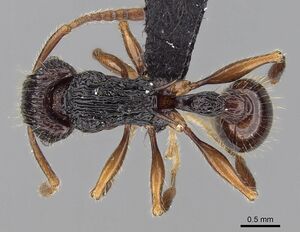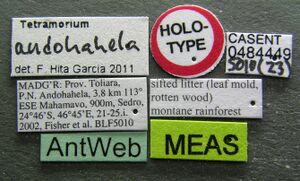Tetramorium andohahela
| Tetramorium andohahela | |
|---|---|

| |
| Scientific classification | |
| Kingdom: | Animalia |
| Phylum: | Arthropoda |
| Class: | Insecta |
| Order: | Hymenoptera |
| Family: | Formicidae |
| Subfamily: | Myrmicinae |
| Tribe: | Crematogastrini |
| Genus: | Tetramorium |
| Species: | T. andohahela |
| Binomial name | |
| Tetramorium andohahela Hita Garcia & Fisher, 2012 | |
Tetramorium andohahela is only found in a strip of localities in southern-eastern Madagascar that ranges from the southernmost locality, Andohahela, north to Ranomafana. All localities are rainforests or montane rainforests located at elevations of 800 to 1250 m. Also, the species was mostly collected from leaf litter.
Identification
A member of the Tetramorium andrei species complex of the Tetramorium tortuosum-species group.
The petiolar node is somewhat variable in its length since it ranges from longer than wide to wider than long (LPeI 93 - 105). This is not of much diagnostic importance, however, since the node always retains its characteristic shape with the posterodorsal corner protruding strongly posteriorly. This extraordinary node shape is absent in the remainder of the T. andrei complex and the whole T. tortuosum group in Madagascar, making T. andohahela straightforwardly recognisable. (Hita Garcia and Fisher 2012)
Keys including this Species
Distribution
Latitudinal Distribution Pattern
Latitudinal Range: 24.76389° to 21.24833°.
| North Temperate |
North Subtropical |
Tropical | South Subtropical |
South Temperate |
- Source: AntMaps
Distribution based on Regional Taxon Lists
Malagasy Region: Madagascar (type locality).
Distribution based on AntMaps
Distribution based on AntWeb specimens
Check data from AntWeb
Countries Occupied
| Number of countries occupied by this species based on AntWiki Regional Taxon Lists. In general, fewer countries occupied indicates a narrower range, while more countries indicates a more widespread species. |

|
Estimated Abundance
| Relative abundance based on number of AntMaps records per species (this species within the purple bar). Fewer records (to the left) indicates a less abundant/encountered species while more records (to the right) indicates more abundant/encountered species. |

|
Biology
Castes
Images from AntWeb
   
| |
| Holotype of Tetramorium andohahela. Worker. Specimen code casent0484449. Photographer Estella Ortega, uploaded by California Academy of Sciences. | Owned by CAS, San Francisco, CA, USA. |
Nomenclature
The following information is derived from Barry Bolton's Online Catalogue of the Ants of the World.
- andohahela. Tetramorium andohahela Hita Garcia & Fisher, 2012: 23, figs. 50, 78-80, 141 (w.) MADAGASCAR.
Unless otherwise noted the text for the remainder of this section is reported from the publication that includes the original description.
Description
Worker
HL 0.94 - 1.10 (1.02); HW 0.95 - 1.15 (1.05); SL 0.75 - 0.90 (0.83); EL 0.20 - 0.25 (0.22); PH 0.49 - 0.60 (0.53); PW 0.71 - 0.85 (0.78); WL 1.28 - 1.53 (1.40); PSL 0.44 - 0.58 (0.50); PTL 0.36 - 0.46 (0.42); PTH 0.37 - 0.48 (0.43); PTW 0.28 - 0.35 (0.32); PPL 0.32 - 0.36 (0.34); PPH 0.37 - 0.48 (0.43); PPW 0.40 - 0.48 (0.44); CI 101 - 106 (103); SI 76 - 82 (79); OI 20 - 22 (21); DMI 54 - 58 (56); LMI 37 - 40 (38); PSLI 45 - 53 (49); PeNI 38 - 43 (41); LPeI 93 - 105 (99); DPeI 73 - 80 (76); PpNI 55 - 59 (56); LPpI 76 - 88 (80); DPpI 121 - 137 (129); PPI 133 - 145 (139) (14 measured).
Head weakly to distinctly wider than long (CI 101 - 106); posterior head margin concave. Anterior clypeal margin medially impressed. Frontal carinae strongly developed, diverging posteriorly, and ending at corners of posterior head margin. Antennal scrobes weakly developed, shallow, narrow, and without defined posterior and ventral margins. Antennal scapes short to moderate, not reaching posterior head margin (SI 76 - 82). Eyes of moderate size (OI 20 - 22). Mesosomal outline in profile flat to weakly convex, moderately marginate from lateral to dorsal mesosoma; promesonotal suture and metanotal groove absent; mesosoma comparatively stout and high (LMI 37 - 40). Propodeal spines very long to extremely long, spinose and acute (PSLI 45 - 53); propodeal lobes well-developed, elongate-triangular, and acute. Petiolar node in profile rectangular nodiform with well-defined angles, weakly higher than long to weakly higher than long (LPeI 93 - 105), anterior and posterior faces almost parallel, anterior face much lower than posterior face, posterodorsal margin situated much higher than anterodorsal, posterior face weakly concave, posterodorsal corner strongly protruding posteriorly; node in dorsal view between 1.2 to 1.4 times longer than wide (DPeI 73 - 80). Postpetiole in profile subglobular, approximately 1.1 to 1.3 times higher than long (LPpI 76 - 88); in dorsal view around 1.2 to 1.4 times wider than long (DPpI 121 - 137). Postpetiole in profile appearing less voluminous than petiolar node, in dorsal view approximately 1.3 to 1.5 times wider than petiolar node (PPI 133 - 145). Mandibles distinctly longitudinally rugose; clypeus longitudinally rugose/rugulose, with four to seven rugae/rugulae, median ruga/rugula often developed and conspicuous, remaining rugae/rugulae often short or irregularly arranged; cephalic dorsum between frontal carinae with eight to ten longitudinal rugae, most rugae running unbroken from posterior head margin to anterior clypeus, few rugae interrupted or with cross-meshes; lateral and ventral head mainly reticulate-rugose, less longitudinally rugose. Mesosoma laterally and dorsally distinctly longitudinally rugose. Forecoxae usually unsculptured, smooth, and shining, rarely with superficial, weak sculpture. Waist segments mainly longitudinally rugose. Gaster completely unsculptured, smooth, and shining. Ground sculpture generally faint to absent everywhere on body. Body with numerous long, fine, standing hairs. Anterior edges of antennal scapes with suberect to erect hairs. Head, mesosoma, waist segments, and gaster brown to dark brown, mandibles, antennae, and legs of much lighter colour, usually yellow.
Type Material
Holotype worker, MADAGASCAR, Toliara, Parc National d'Andohahela, Col du Sedro, 3.8 km 113° ESE Mahamavo, 37.6 km 341° NNW Tolagnaro, 24.76389 S, 46.75167 E, 900 m, montane rainforest, sifted litter (leaf mold, rotten wood), collection code BLF05010, 21.-25.I.2002 (B.L. Fisher, C. Griswold, et al.) (California Academy of Sciences: CASENT0454449). Paratypes, 25 workers with same data as holotype (The Natural History Museum: CASENT0484441; CASC: CASENT0454555; CASENT0484356; CASENT0484390; CASENT0484395; CASENT0484407; CASENT0484417; CASENT0484430; CASENT0484433; CASENT0484434; CASENT0484435; CASENT0484472; CASENT0484482; CASENT0484487; CASENT0484488; CASENT0484489; CASENT0484494; CASENT0484499; CASENT0484508; CASENT0484520; CASENT0484524; Museum of Comparative Zoology: CASENT0484469; Musee d'Histoire Naturelle Genève: CASENT0484510; Naturhistorisches Museum, Basel: CASENT0484555).
Etymology
The new species is named after the type locality, the Andohahela National Park, which harbours an extraordinary variety of landscapes and habitats, and is of special importance for the conservation of biodiversity in Madagascar. The species epithet is a noun in apposition, and thus invariant.
References
References based on Global Ant Biodiversity Informatics
- Hita Garcia F., and B. L. Fisher. 2012. The ant genus Tetramorium Mayr (Hymenoptera: Formicidae) in the Malagasy regiontaxonomic revision of the T. kelleri and T. tortuosum species groups. Zootaxa 3592: 1-85.

